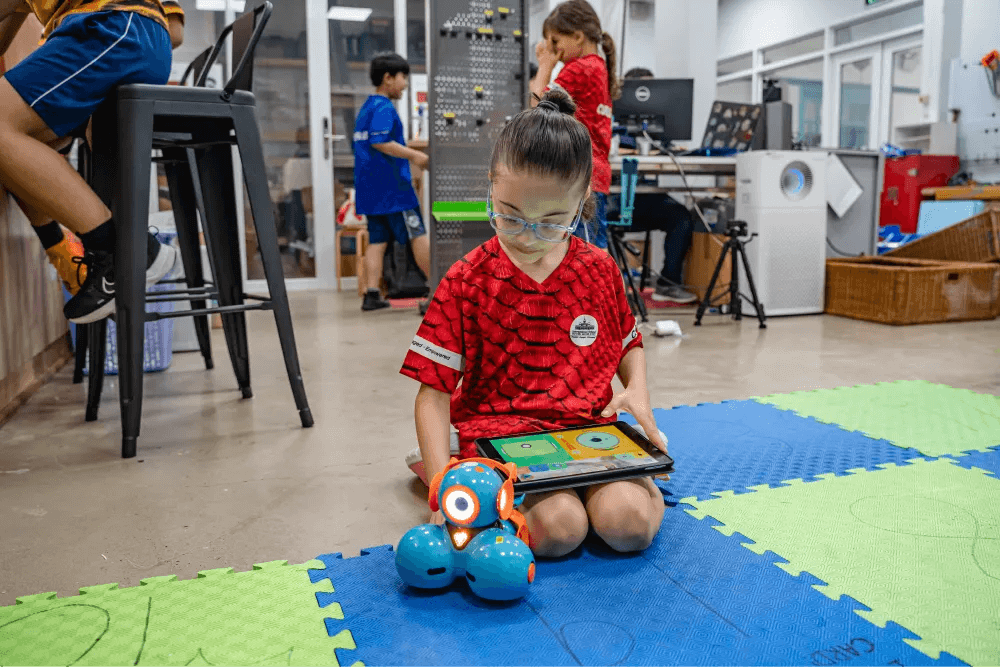How STEM Education Can Shape Future Opportunities
Table of Contents
STEM education, encompassing Science, Technology, Engineering, and Mathematics, holds the key to shaping future opportunities in an increasingly complex world. In today’s knowledge-driven society, proficiency in STEM disciplines enables students to excel both academically and in real life.
This blog explores how STEM education can shape the future and how schools can effectively integrate STEM into their curricula.
Here are a few ways in which STEM Education can help shape future opportunities:
- Prepare students for future careers
- Develop students’ citizenship ethics
- Familiarize students with modern technology
- Develops students’ essential skills
Prepares Students for Future Careers
In the rapidly evolving Fourth Industrial Revolution (4IR) landscape, technical knowledge is tailored to the demands of diverse career pathways and industries. This section explores “how can STEM education shape the future?” by equipping the foundational competencies to navigate future careers effectively.
- Engineering and Technology: Delve into the practical application of engineering principles and technological advancements, encompassing the utilization of techniques, procedures, and equipment across various domains.
- Computers, Electronics, and Programming: Explore the realm of circuitry, electronic components, computer hardware, and software, delving into applications and programming intricacies.
- Design and Technology: Examine the methodologies and principles underpinning precision technical planning, encompassing the creation of detailed blueprints, drawings, and models essential for innovation.

- Mathematics: Investigate the foundational aspects of arithmetic, algebra, geometry, calculus, and statistics and their real-world applications, which are required for problem-solving and decision-making.
- Physics: Unravel the complexities of physical principles and laws, exploring their applications in understanding fluid dynamics, material properties, and mechanical processes vital for technological advancement.
- Chemistry: Dive into chemical composition, structure, and transformations, encompassing their industrial applications, safety protocols, and environmental implications.
- Biology: Learn about plant and animal organisms, their interdependencies, and interactions with the environment, shedding light on the interdisciplinary nature of STEM education.
Develops Students’ Citizenship Ethics
STEM education promotes moral principles and attitudes necessary for rational action and scientific inquiry. Therefore, it encourages the development of ethical citizenship.
These principles contribute to a STEM approach characterized by objective thinking, systematic processes, and adherence to values such as:
- Be curious in researching: Cultivating interest in the environment and self-initiated exploration.
- Be honest in recording and reporting: Maintaining integrity and accuracy in documenting observations and experimental findings.
- Be objective: Recording data impartially and explaining observations rationally.
- Be open-minded: Embracing diverse opinions, demonstrating flexibility, and making evidence-based decisions.
- Be diligent and persevere: Demonstrating determination, accepting criticism, and overcoming challenges.

- Be systematic: Conducting activities in an organized manner and adhering to appropriate timelines.
- Be cooperative: Collaborating effectively in activities and experiments.
- Be responsible: Prioritizing safety and considering the consequences of actions.
- Be precise: Ensuring accuracy in data collection and measurement.
- Take appropriate risks: Being open to exploring new approaches and areas within STEM.
- Make ethical decisions: Evaluating alternatives in alignment with ethical principles.
Familiarizes Students with Modern Technology
Regarding the benefits of a STEM education, students are exposed to and engage with many modern technological systems, concepts, and operations, encouraging a comprehensive understanding of contemporary digital landscapes.
Through practical application and exploration, students get to know various facets of modern technology, including:
- Technology systems: Utilizing various systems, students can navigate digital environments, collaborate on projects, access information, and communicate effectively while developing foundational cybersecurity practices. These systems include operating systems, learning management systems, virtual systems, and network systems.
- Software application functions: Performing formatting, editing, file management, keyboarding techniques, and data storage to facilitate efficient digital workflows.
- Troubleshooting: Solving minor technical issues with hardware and software and debugging coding errors through systematic problem-solving approaches.
- Function and purpose: This includes evaluating and selecting appropriate methods for scientific inquiry or engineering design activities. It also involves leveraging technology applications, devices, and online environments for collaboration, data analysis, and communication.

- Productivity tools: Employing applications for time management, documentation, organization, sharing, communication, and digital security to enhance efficiency and effectiveness in STEM endeavors.
- Research tools: Accessing information resources, collecting data, managing references, and conducting literature reviews using various digital tools and platforms.
- Design and creation tools: Utilizing graphic organizers, digital illustration, modeling, prototyping, and presentation tools to ideate, create, and showcase projects effectively.
- Data tools: Employing digital instruments, data analysis software, and data visualization tools to gather, analyze, and present data in meaningful ways for scientific inquiry and engineering design activities.
Develops Students’ Essential Skills
Within STEM education, students acquire diverse essential skills that are integral to their cognitive development and future success in STEM fields and beyond. These skills encompass:
Cognitive Skills
STEM education fosters critical, creative, and analytical thinking alongside problem-solving abilities essential for navigating complex challenges.
- Critical Thinking: STEM education cultivates the ability to evaluate information objectively, analyze complex issues, and formulate informed judgments. Students develop critical thinking skills through activities such as analyzing scientific data, evaluating experimental results, and assessing the validity of arguments.
- Information Processing: In an era inundated with vast amounts of data, STEM education equips students with the skills to manage, organize, and interpret information effectively. From conducting research to synthesizing findings, students learn to navigate digital landscapes and extract relevant insights.
- Analytical Thinking: STEM education emphasizes analytical thinking, requiring students to systematically apply mathematical and scientific principles to solve problems. Students learn to comprehend and apply solutions in various domains using logical reasoning and an awareness of empirical evidence.

- Problem-solving: STEM education promotes problem-solving skills essential for addressing real-world challenges. Whether designing experiments or engineering solutions, students engage in the iterative process of identifying problems, analyzing data, and generating innovative solutions.
- Scientific Investigation: Through hands-on inquiry-based learning, students engage in scientific investigation to explore natural phenomena and validate hypotheses. Students develop science process skills fundamental to scientific inquiry by conducting experiments and analyzing data.
- Computational Thinking: STEM education integrates computational thinking skills, enabling students to formulate and solve problems using algorithms and logical reasoning. From basic ICT skills to coding proficiency, students leverage technology to address complex challenges in STEM fields.
- Design Thinking: STEM education embraces design thinking methodologies, promoting creativity and innovation in problem-solving. Students participating in iterative design processes develop solutions inspired, ideated, and guided by empathy.
- Creativity and Innovation: STEM education nurtures creativity and innovation, encouraging students to explore novel ideas and make meaningful connections. Students drive positive change through entrepreneurship and inventive thinking and contribute to technological advancements.
Manipulative and Technological Skills
STEM education emphasizes developing manipulative skills for safely and effectively handling scientific and technical equipment. Students gain proficiency in conducting experiments, operating laboratory instruments, and utilizing advanced technology.
For example, in physics laboratories, students learn to calibrate equipment, perform experiments on motion and energy, and analyze data using various measurement tools.

Additionally, technological skills are honed to adapt to the rapid pace of technological change and the evolving demands of the labor market.
Vocational and technical education institutions provide predictive and responsive training that aligns with industry needs, preparing students for careers in fields such as electrical engineering, automotive technology, and mechatronics.
Collaboration and Communication Skills
The importance of STEM education also lies in its effective collaboration and communication skills, which are essential for teamwork and project-based learning.
Students learn to collaborate, share ideas, and communicate findings clearly and precisely. Through group projects, debates, and presentations, students develop interpersonal attributes such as leadership, negotiation, and conflict resolution.

Moreover, they cultivate ethical awareness, mutual respect, and cultural sensitivity, enabling them to navigate diverse professional environments and contribute meaningfully to collaborative endeavors.
Ultimately, proficiency in collaboration and communication equips students to work autonomously and collaboratively, convey information effectively to stakeholders, and nurture a culture of shared responsibility and achievement.
How to Integrate STEM Into Education?
Integrating STEM into education can bridge the gap between discipline-based learning and interdisciplinary/transdisciplinary methods, fostering holistic understanding and application of STEM concepts.
- Focusing on Real-World Authentic Problems: Providing students with opportunities to tackle authentic, real-world problems encourages the development of critical thinking and problem-solving skills across disciplines. For example, students may investigate environmental issues like pollution or climate change and propose innovative solutions through collaborative research and analysis.
- Placing a Design Activity: Incorporating design activities within assignments challenges students to apply STEM knowledge in practical contexts. Purposeful design and inquiry tasks integrate technological design with scientific inquiry, prompting students to devise creative solutions to complex problems. For instance, students may design and prototype solutions to improve energy efficiency or enhance accessibility in their community.

- Applying Problem-Based Learning: Problem-based learning (PBL) engages students in researching and applying knowledge to solve defined problems. Through tackling unstructured, interdisciplinary problems, students strengthen their critical thinking and teamwork abilities while finding workable solutions. Instructors facilitate the learning process, guiding students with inquiry and reflection without providing direct solutions. For example, students may tackle challenges related to sustainable development or healthcare innovation, facilitating holistic problem-solving skills.
- Applying Project or Inquiry-Based Learning: Project or inquiry-based learning emphasizes collaborative inquiry and goal-oriented learning experiences. While similar to PBL, these approaches afford instructors a stronger role in facilitating learning and providing support. Students engage in investigative projects, exploring topics of interest and setting parameters for inquiry, encouraging autonomy and creativity. For instance, students may conduct scientific investigations into local ecosystems or engineering projects to address community needs, promoting hands-on learning and innovation.
ISHCMC answers the question, “how can STEM education shape the future?” by integrating it into our education. At ISHCMC, we recognize the importance of nurturing students’ problem-solving skills through our International Baccalaureate (IB) programs. Our curriculum, spanning the Primary Years Programme (PYP), Middle Years Programme (MYP), and Diploma Programme (DP), emphasizes inquiry-based learning and critical thinking, preparing students to excel academically and personally.

With the IB’s holistic approach to education, students at ISHCMC are actively engaged in their learning, taking ownership of their educational journey and applying their knowledge to meaningful action in their local communities. Take the first step towards a brighter future for your child by applying to ISHCMC today!
FAQs
Beside exploring “how can STEM education shape the future?”, we will uncover answers to frequently asked questions, covering topics like curriculum design and career prospects.

1. What are examples of STEM jobs?
STEM careers encompass a wide range of professions that involve scientific inquiry, technological innovation, engineering design, and mathematical analysis.
- Technical Writer: Prepare instruction manuals and technical documents.
- Computer Programmer: Design and create software programs.
- Biologist: Study living organisms and their interactions.
- Financial Analyst: Analyze investment performance and provide advice.
- Chemist: Study chemicals and their environmental interactions.
- Civil Engineer: Design and plan infrastructure projects.
- Mathematician: Perform research to develop mathematical principles.
2. What are the differences between STEM and NON-STEM courses?
STEM courses focus on developing technical and analytical skills through subjects like science and engineering, preparing students for specialized fields. Non-STEM courses emphasize critical thinking, communication, and versatility. They cover areas such as business, law, and the arts, suitable for diverse career paths.
3. How can parents support students in STEM education?
Parents can support students in STEM education by providing STEM materials and opportunities, such as chemistry sets, calculators, and computer clubs. Moreover, they can encourage their children’s participation in after-school or online programs, ensure equal access to technology, and involve families in joint activities to stimulate collaborative learning.






